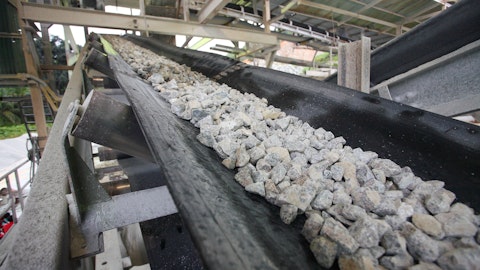Ward Nye: Yes. No, I think it’s been Dave from my perspective, a fairly predictable and I think in large measure because we went for such an extended period of time, without more money coming from the federal government in a meaningful way on that. So, if you think about what happened, we had a decade plus of continuing resolutions. Then we had the FAST Act, that didn’t have more money, but it did have more time. And so now what’s happened is, you’ve had that very attractive double whammy of hey, here comes more money. Here comes more time. And you also had DOTs who had actually been building up their own budgets, for about 15 years because they weren’t getting more money and more time from the federal government. So I think what we’re going to see particularly in Martin Marietta states is, it’s not so much driven by maintenance and repair.
It’s going to be more driven by bringing in new capacity. And that’s important for a number of reasons. Number one, our states have had a lot of people move to them. So, if we’re simply looking at overall population trends, I mean it’s pretty eye-popping to think about the fact that, Texas has led all the states and population gains over the past decade adding four million people. If we’re looking at Colorado, their population has grown 14.8% just since 2010. And mean North Carolina has been one of the fastest-growing states in the country. Georgia is going to move up to number 8 in the country in population. So if you think about, why these states need to add capacity, as opposed to maintenance and repair. That’s a big reason. And if you’re thinking about what happens from a lag perspective, on rather than putting new asphalt, on top of old asphalt but rather adding a new lane or building new roads, it frankly takes a little bit longer.
Now, the punchline is it ends up being considerably more aggregates intensive. So, for us, it’s like a big birthday. It’s worth the wait sometimes. So, we feel like good things are coming from this but I think that’s really driving that lag that we’ve seen the dollars are there. And you can see where they are. You can see what the state DOT budgets are. But again I think it’s those states those budgets those population inflows that are driving a different nature of construction. What we’ll see in Charlotte, what we’ll see in Atlanta, what we’ll see in Dallas is going to be a very different story than what you’ll see in New York or what you’ll see in Chicago.
David MacGregor: Great. Thanks very much.
Ward Nye: Thank you, David.
Operator: Your next question comes from Michael Dudas with Vertical Research. Please go ahead.
Michael Dudas: Good morning Jacklyn, Jim, Ward.
Ward Nye: Good morning, Michael.
Michael Dudas: You’ve been terrific observations about the markets and some of the puts and takes heading into end of this year 2024. Just wondering as you look at the residential side of the business in your important states it seems — we’re at a — is that the flywheel that could impact positively expectations on volume given it seems like we’re at a bottom or in this kind of longer base bottom given the affordability issues. Is that kind of where the help could come if volumes could get better? And is that a market that you’d be able to take advantage of given your positioning in your — certainly your backlog and your ability to serve?
Ward Nye: Yes. Look, I think the answer Michael is yes and yes to all of the above. It’s interesting because you’ve got two issues relative to housing in the United States today. We’ve talked about one of them and that is affordability and clearly seeing mortgage rates move to 23-year highs drive some of that. The other issue that doesn’t get the airtime that it probably should but it does in our states is availability. And that’s a big issue today. And single-family housing in the US is structurally underbuilt. I mean it’s a practical matter it ought to be trending comfortably over one million starts a year at least as we drill it down to the markets in which most of our business is because again we’re back to those population trends that I mentioned in the dialogue with Dave MacGregor just a few minutes ago.
If you come to Raleigh, your biggest issue is can you find a house. Same issue in Charlotte. Same issue in Atlanta. In various degrees, the same issues in Dallas-Fort Worth and in Colorado today. So, to the extent that there could be some upside there. Could it be single-family housing-driven? I think so. And for example several things are happening. Our homebuilders looking at having their own mortgage companies within homebuilding companies? They are. Are they doing that because they want to keep building? They do. Do they want to keep building because they know the market is there? Absolutely. And in some instances are they building and basically building to rent even in the near-term because they recognize that they can do that. So, I think your point around a swing factor on housing is important.
And I think it’s relevant to say keep in mind single-family housing is two to three times more aggregates-intensive than is multifamily. So, if you’re watching housing look is it nice to see multifamily go? Yes. Is it really nice to see single-family go? The answer is yes. But I think what we’ve just described is worth watching and could be a build in 2024. And I hope that helps Michael.
Michael Dudas: It sure does. Excellent Ward. Thank you.
Operator: [Operator Instructions] Your next question comes from Adam Thalhimer with Thompson Davis. Please go ahead.
Adam Thalhimer: Hey, good morning guys. Great quarter. Two quick questions, getting late in the call. Two quick questions. One where do you want us for Q4 because the range is pretty wide. And I’m just curious if we wanted to bake in an early onset to winter where would that put us? And then the second question is do you ever see yourself recreating what you’ve built in Texas and other geographies?
Ward Nye: Well, that’s two big questions for a guy late in the call today Adam. A couple of things. I’ll take the second part of that. I’ll leave the first part to Jim. Texas is a tremendous market. And when we bought TXI and when we’ve done some of the moves that we’ve made in Texas since then frankly we thought it was going to be that kind of a market. But at the same time we’re in some other markets today that are enormously attractive. Do we think we can do some very great things in California? Yeah, I think we can. Can we continue to grow our business in places like Florida and still in Texas and in Tennessee and others? The short answer is yes. But one thing I think is so important for me to say Adam is you should expect us to continue to be an aggregates-led company.
And I think that part of what is so evident in these numbers is again how durable that is. Now with respect to Q4, I’ll pivot over to Jim and he can talk to you a little bit more about how we see some puts and takes on that. But frankly a lot of it is going to be driven by when does winter show up in different parts of our business. So Jim?
Jim Nickolas: Yeah. So Q4 I would say look generally speaking look at the midpoint of whatever we put out that sort of — the best way to think about it. What could push it to the bottom end? Ward mentioned obviously bad weather, rainy weather in Texas, early winter in the north part of our footprint. And then, of course, there’s cost timing and shifts. There’s nothing fundamentally happening that’s troubling. Costs could shift from one quarter to the next causing volatility. It was slipped into Q1 that would help Q4. If they don’t that would hurt Q4. So I think I’d just stick with the midpoint for now Adam and go with that.
Adam Thalhimer: Great. Thanks guys.
Ward Nye: Thank you, Adam.
Operator: There are no further questions at this time. Please proceed.
Ward Nye: Thank you again for joining today’s earnings conference call. To conclude our strong third quarter results underscore the resiliency and secular durability of our aggregates-led business model through various business cycles. Our focus remains on building the world’s safest, most resilient and best-performing aggregates led public company for the benefit of our shareholders, customers, employees and other stakeholders. Thanks to the disciplined execution of SOAR and the fidelity of our teams to safety, commercial and operational excellence. Martin Marietta is poised to continue delivering sustainable growth and superior shareholder value in 2024 and beyond. We look forward to sharing our fourth quarter and full year 2023 results with you in February. As always we’re available for any follow-up questions. Thank you for your time and continued support of Martin Marietta.
Operator: Ladies and gentlemen this concludes your conference call for today. We thank you for participating and ask that you please disconnect your lines.
Follow Martin Marietta Materials Inc (NYSE:MLM)
Follow Martin Marietta Materials Inc (NYSE:MLM)
Receive real-time insider trading and news alerts





